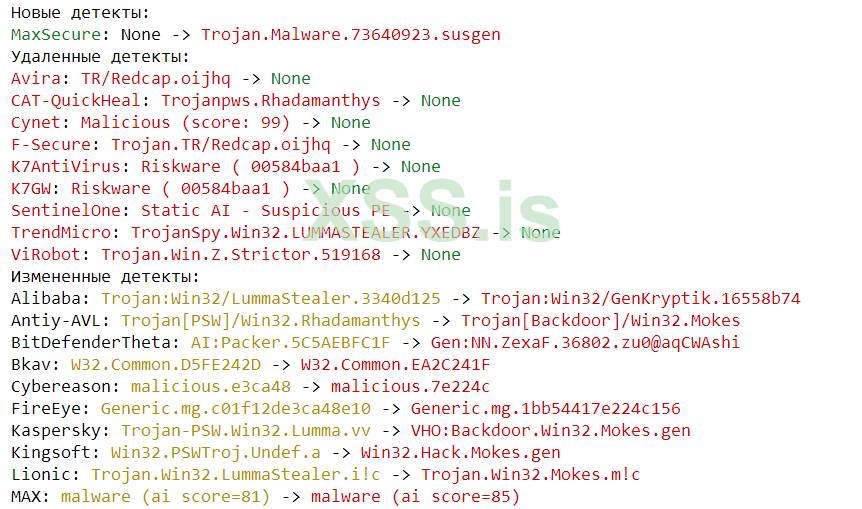这里有一些有趣的 Python 代码,可让您从 VirusTotal 获取恶意软件报告并进行比较。听起来很有趣,不是吗?让我们仔细看看它。

介绍
该代码首先导入必要的库,例如用于处理 HTTP 请求的 requests 和用于在终端中输出漂亮文本的 colorama。
VirusTotalAPI 类
接下来,定义 VirusTotalAPI 类,它允许您与 VirusTotal API 进行交互。它在初始化时接受您的 API 密钥,并具有 download_report 方法,可以通过哈希值下载文件的报告。
报表管理类
以下 ReportManager 类使报表的处理变得更加容易。它将报告缓存到磁盘,因此不必再次下载。 get_report 方法检查报告是否在缓存中,如果没有,则通过 VirusTotalAPI 加载它。
检测比较器类
DetectionComparator 类是我们节目中真正的明星!它会比较两个报告并确定哪些防病毒引擎检测到新威胁,哪些引擎停止检测它们,以及哪些引擎更改了结果。这有助于跟踪恶意软件检测的变化。
检测打印机类
最后,DetectionPrinter 类负责将比较结果精美地输出到终端。它使用 colorama 库以不同颜色突出显示新的、删除的和更改的检测。
主要功能
在主函数中,类被初始化,报告被加载,结果被比较和显示。您可以更改文件哈希值以进行测试或使用您的 VirusTotal API 密钥。
完整代码
import requests
import json
import os
from colorama import init, Fore, Style
init() # Инициализация colorama
class VirusTotalAPI:
def __init__(self, api_key):
self.api_key = api_key
self.base_url = "https://www.virustotal.com/vtapi/v2"
def download_report(self, file_hash):
url = f"{self.base_url}/file/report?apikey={self.api_key}&resource={file_hash}"
response = requests.get(url)
if response.status_code == 200:
return response.json()
else:
print(f"Ошибка при загрузке отчета для хеша {file_hash}")
return None
class ReportManager:
def __init__(self, api_key):
self.api = VirusTotalAPI(api_key)
def get_report(self, file_hash):
filename = f"C:/temp/{file_hash}.json"
if os.path.exists(filename):
print(f"Отчет для хеша {file_hash} уже существует на диске.")
with open(filename) as f:
return json.load(f)
else:
report = self.api.download_report(file_hash)
if report:
with open(filename, 'w') as f:
json.dump(report, f)
return report
class DetectionComparator:
def compare(self, report1, report2):
new_detections = {}
removed_detections = {}
changed_detections = {}
for engine, result in report2['scans'].items():
if engine in report1['scans']:
if result['detected'] != report1['scans'][engine]['detected']:
if result['detected']:
new_detections[engine] = {
'old_result': report1['scans'][engine]['result'],
'new_result': result['result']
}
else:
removed_detections[engine] = {
'old_result': report1['scans'][engine]['result'],
'new_result': result['result']
}
elif result['detected'] and result['result'] != report1['scans'][engine]['result']:
changed_detections[engine] = {
'old_result': report1['scans'][engine]['result'],
'new_result': result['result']
}
else:
if result['detected']:
new_detections[engine] = {
'old_result': None,
'new_result': result['result']
}
for engine, result in report1['scans'].items():
if engine not in report2['scans']:
if result['detected']:
removed_detections[engine] = {
'old_result': result['result'],
'new_result': None
}
return new_detections, removed_detections, changed_detections
class DetectionPrinter:
def print_detections(self, new_detections, removed_detections, changed_detections):
if new_detections:
print("Новые детекты:")
for engine, results in new_detections.items():
print(
f"{Fore.GREEN}{engine}{Style.RESET_ALL}: {results['old_result']} -> {Fore.RED}{results['new_result']}{Style.RESET_ALL}")
if removed_detections:
print("Удаленные детекты:")
for engine, results in removed_detections.items():
print(
f"{Fore.RED}{engine}{Style.RESET_ALL}: {Fore.RED}{results['old_result']}{Style.RESET_ALL} -> {Fore.GREEN}{results['new_result']}{Style.RESET_ALL}")
if changed_detections:
print("Измененные детекты:")
for engine, results in changed_detections.items():
print(
f"{engine}: {Fore.YELLOW}{results['old_result']}{Style.RESET_ALL} -> {Fore.RED}{results['new_result']}{Style.RESET_ALL}")
def main():
api_key = ""
hash1 = "2593f6685eb741cac83c2529e5d69fda18a82007e1c4fc721bfa6c286c678db2"
hash2 = "cc6ed492e33761a111a2717823f5f1f6de9365aa22e042364eadefe16c1024a8"
if not os.path.exists(r"C:\temp"):
os.makedirs(r"C:\temp")
report_manager = ReportManager(api_key)
report1 = report_manager.get_report(hash1)
report2 = report_manager.get_report(hash2)
if report1 and report2:
comparator = DetectionComparator()
new_detections, removed_detections, changed_detections = comparator.compare(report1, report2)
printer = DetectionPrinter()
printer.print_detections(new_detections, removed_detections, changed_detections)
if __name__ == "__main__":
main()就是这样!现在您已经了解这段代码是如何工作的以及它的作用了。不要忘记运行它并在终端中查看结果。祝你学习 Python 愉快!

Leave a Reply